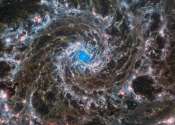Hubble views cosmic dust lanes
Featured in this new image from the NASA/ESA Hubble Space Telescope is a nearly edge-on view of the lenticular galaxy NGC 4753. Lenticular galaxies have an elliptical shape and ill-defined spiral arms.

Featured in this new image from the NASA/ESA Hubble Space Telescope is a nearly edge-on view of the lenticular galaxy NGC 4753. Lenticular galaxies have an elliptical shape and ill-defined spiral arms.
Astronomy
May 17, 2024
0
67

Deep in outer space, invisible hands mold the universe. One is dark matter, an unseen substance thought to bind distant galaxies. The other is dark energy, a force believed to push stellar structures apart with gravity-defying ...
Quantum Physics
May 15, 2024
0
48

A research team has, for the first time, realized the quantum amplification of an extremely weak magnetic field by using dark spin, with the magnetic field magnification exceeding a factor of 5,000 and the single magnetic ...
Condensed Matter
May 15, 2024
0
10

Primordial black holes (PBHs) have recently received much attention in the physics community. One of the primary reasons is the potential link to dark matter. In effect, if PBHs can be proven to exist, there's a very good ...
Astronomy
May 14, 2024
3
43

The Large and Small Magellanic Clouds are well-known satellite galaxies of the Milky Way, but there are more. It is surrounded by at least 61 within 1.4 million light years (for context the Andromeda galaxy is 2.5 million ...
Astronomy
May 13, 2024
0
74

One of the biggest mysteries in astrophysics today is that the forces in galaxies do not seem to add up. Galaxies rotate much faster than predicted by applying Newton's law of gravity to their visible matter, despite those ...
Astronomy
May 10, 2024
13
1834

Using the Dark Energy Camera (DECam), Argentinian astronomers have investigated the environment of a galactic globular cluster known as NGC 6355. The study, presented in a paper published May 2 on the pre-print server arXiv, ...

The Gum Nebula is an emission nebula almost 1400 light-years away. It's home to an object known as "God's Hand" among the faithful. The rest of us call it CG 4.
Astronomy
May 8, 2024
0
62

Scientific evidence for dark matter comes from observing how it influences the motion of stars and galaxies. Scientists believe that dark matter may consist of particles. To search for these particles and their billiard ball-like ...
General Physics
May 7, 2024
0
262

Primordial black holes are hypothetical objects formed during the earliest moments of the universe. According to the models, they formed from micro-fluctuations in matter density and spacetime to become sand grain-sized mountain-massed ...
Astronomy
May 6, 2024
1
90
Darkness, in contrast with brightness, is a relative absence of visible light. It is the appearance of black in a color space. When light is not present, rod and cone cells within the eye are not stimulated. This lack of stimulation means photoreceptor cells are unable to distinguish color frequency and wavelength. The resulting perception is achromatic and in the case of darkness, black. The emotional reaction to darkness has metaphorical importance in many cultures.
This text uses material from Wikipedia, licensed under CC BY-SA